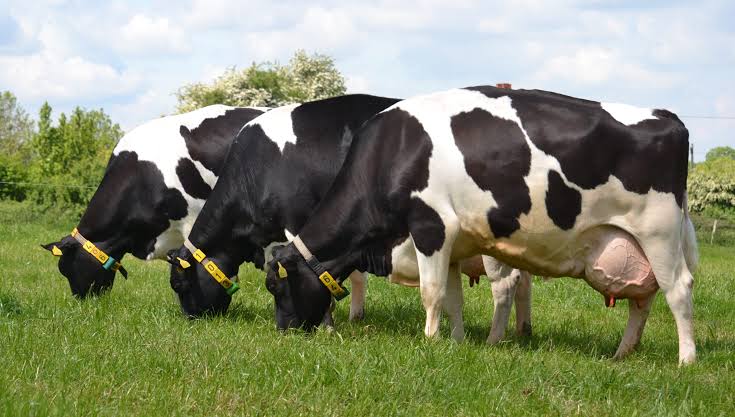Best Dairy Breeds for Milk Production in Africa 2025 – Top High-Yield Cows for Profitable Dairy Farming
Discover the best dairy cow breeds for milk production in Africa. Learn about Friesian, Jersey, Ayrshire, Guernsey, and indigenous breeds that produce high milk yields and thrive in African climates.
Africa’s Rising Dairy Farming Revolution
Dairy farming is rapidly becoming one of the most profitable agribusiness ventures in Africa. As demand for fresh milk, yogurt, butter, and cheese rises across cities and rural communities, farmers are shifting to high-yield dairy breeds that promise more milk per cow, better quality, and faster returns.
But not all cow breeds thrive under African conditions. The best breeds combine high milk production, heat resistance, disease tolerance, and low maintenance costs.
This article explores the top 10 best dairy breeds for milk production in Africa, their characteristics, average yields, and how farmers can maximize profits through proper breeding and feeding.
1. Friesian (Holstein Friesian) – The World’s Top Milk Producer
Keywords: Friesian cow breed, Holstein Friesian Africa, high milk production cow
The Friesian, also known as Holstein Friesian, is the most popular dairy breed in the world — and one of the most productive in Africa. Originally from the Netherlands, Friesians are famous for their high milk yield and adaptability when well-managed.
Key Characteristics:
- Distinct black-and-white coat
- Excellent milk producers (20–40 liters/day)
- Calm temperament and easy to milk
Advantages:
Produces the highest milk volumes
Fast growth and early maturity
Adapts well to moderate African climates
Best suited regions: Kenya highlands, Tanzania, Uganda, Rwanda, South Africa
Pro Tip: Friesians require quality feeds and consistent veterinary care. Crossbreeding with local breeds improves heat resistance and disease tolerance.
2. Jersey – The Butter and Cream Queen
Keywords: Jersey cow Africa, dairy farming Kenya, butter production cows
The Jersey breed is small in size but mighty in milk richness. Originating from the Channel Islands, Jerseys are loved for their high butterfat content, making them ideal for butter, cheese, and yogurt production.
Key Characteristics:
- Light brown coat and big eyes
- Yields 15–25 liters of milk/day
- Milk rich in butterfat (4.5–5.5%)
Advantages:
High-quality milk for dairy processing
Tolerant to heat and moderate drought
Requires less feed than larger breeds
Best suited regions: Eastern and Central Africa, especially semi-arid areas
Pro Tip: Jerseys perform well on natural pasture with mineral supplements. Ideal for smallholder farmers and women entrepreneurs.
3. Ayrshire – The Balanced Dairy Performer
Keywords: Ayrshire breed Africa, best dairy breed for farmers, medium-sized dairy cow
The Ayrshire breed, originally from Scotland, offers a great balance between milk yield, hardiness, and adaptability. It’s a favorite among East African farmers who want moderate feed requirements and good production.
Key Characteristics:
- Red and white spotted coat
- Milk yield: 18–30 liters/day
- Strong hooves and legs for grazing
Advantages:
Excellent milk quality and quantity balance
Long productive lifespan
Tolerant to African conditions
Best suited regions: Kenya, Uganda, Ethiopia, Zimbabwe
Pro Tip: Ayrshires thrive in open grazing and perform well under zero-grazing if properly fed with silage and legumes.
4. Guernsey – The Golden Milk Breed
Keywords: Guernsey cow, golden milk, top milk-producing breeds Africa
Guernseys produce golden-colored milk due to high beta-carotene content, making them a premium choice for nutritious milk lovers. Though not as common in Africa, their adaptability is increasing.
Key Characteristics:
- Light red and white coat
- Milk yield: 16–25 liters/day
- Rich, high-butterfat milk
Advantages:
High-quality milk with great taste
Gentle temperament
Adapts to moderate climates
Best suited regions: Cooler highlands of Kenya, Tanzania, and Rwanda
Pro Tip: Mix Guernsey bloodlines with local Zebu cows for stronger disease resistance.
5. Sahiwal – The Tropical Dairy Powerhouse
Keywords: Sahiwal dairy breed, tropical cow Africa, heat resistant dairy cows
Originating from Pakistan and India, Sahiwal cows are among the most heat-tolerant and disease-resistant dairy breeds in Africa. They are ideal for arid and semi-arid regions where exotic breeds struggle.
Key Characteristics:
- Reddish-brown coat with short horns
- Milk yield: 8–15 liters/day
- Excellent fertility and mothering instincts
Advantages:
High resistance to ticks and diseases
Thrives in hot climates
Low maintenance cost
Best suited regions: Kenya’s Rift Valley, northern Uganda, Sudan, Nigeria
Pro Tip: Sahiwals make excellent crossbreeds with Friesians and Ayrshires to improve milk yield and adaptability.
6. Brown Swiss – The Long-Lived Producer
Keywords: Brown Swiss Africa, dairy cows for milk and cheese production
The Brown Swiss breed is known for its calm temperament, strong body, and consistent milk flow. It produces milk with a perfect balance of protein and butterfat, ideal for cheese making.
Key Characteristics:
- Greyish-brown coat with strong frame
- Milk yield: 20–30 liters/day
- Long lifespan and disease tolerance
Advantages:
Long milking lifespan
Excellent for both milk and cheese
Adaptable to mixed climates
Best suited regions: Highlands of Kenya, Ethiopia, South Africa
Pro Tip: Provide quality forage and minerals — Brown Swiss cows reward farmers with steady milk production even during dry seasons.
7. Ankole (Watusi) – Africa’s Heritage Breed
Keywords: Ankole cow Africa, indigenous dairy breeds, milk from African cows
The Ankole-Watusi, native to East Africa, is an iconic indigenous breed recognized by its long horns. While not the highest in milk yield, it offers resilience, disease resistance, and cultural value.
Key Characteristics:
- Long-horned, red or brown body
- Milk yield: 4–8 liters/day
- Very hardy under harsh conditions
Advantages:
Extremely resilient and low-cost
Resistant to tropical diseases
Produces nutritious milk with good butterfat
Best suited regions: Uganda, Rwanda, Burundi, Tanzania
Pro Tip: Crossbreed Ankole with Friesian or Jersey cows for higher milk yield while maintaining hardiness.
8. Crossbred Cows – The Hybrid Advantage
Keywords: crossbred dairy cows, best hybrid dairy breeds, African dairy hybrids
Crossbreeding combines the best traits of exotic and local breeds. Farmers across Africa are achieving impressive milk yields by crossing Friesians, Jerseys, or Ayrshires with indigenous Zebu or Sahiwal cattle.
Advantages:
Improved heat resistance
Better disease tolerance
Consistent milk yield (10–25 liters/day)
Pro Tip: Always consult certified breeding programs or artificial insemination centers for quality semen and predictable results.
Key Factors That Affect Milk Production
To achieve the best results, farmers must focus on:
- Quality feeding – Balanced rations, silage, and mineral supplements.
- Proper housing – Clean, ventilated, and comfortable sheds.
- Veterinary care – Vaccination, deworming, and disease control.
- Breeding management – Controlled mating and artificial insemination.
- Water supply – Cows require at least 40–60 liters/day for optimal milk yield.
Remember: A good breed will only perform as well as the management allows. Feed, hygiene, and care directly influence productivity.
The Future of Dairy Farming in Africa
Africa’s dairy industry is growing fast — powered by innovation, improved breeds, and better farm management. Farmers who invest in high-yield, climate-adapted dairy breeds can expect strong profits and steady milk supply year-round.
From the Friesian’s massive output to the Sahiwal’s toughness and Jersey’s butterfat richness, choosing the right breed is the foundation of profitable dairy farming.
As governments and agribusiness investors continue to support dairy farmers with training, loans, and AI services, the future of milk production in Africa looks brighter than ever.






